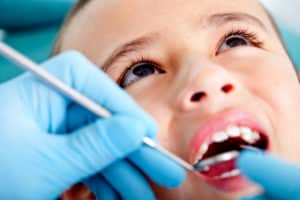Using Physical Restraint in Pediatric Dentistry
Exploring the Use of Physical Restraint in Pediatric Dentistry
You may have seen the recent segment on CBS Channel 13 in reference to a child who was physically restrained during his dental treatment. This incident has sparked a heated debate. Why do Pediatric Dentists sometimes use physical restraints? (Often referred to as ‘Papoose Boards’) Under what circumstances are they appropriate? What about alternatives? Let’s explore the indicators for physical restraint in Pediatric Dentistry.
As Pediatric Dentists, our goal is always to begin working with our small patients before he or she turns one. Click here for more information about early preventative care.
Notwithstanding the obvious benefits of early exams and education, an essential part of our job is to help children become comfortable with the dentist – a task which involves patience and respect for the child’s natural apprehension. Most of our patients love coming to see us – even when they need a filling. Why? We have laid the foundation early on of making them feel comfortable and empowering them to take pride in their oral health.
A few children, however, may have unreasonable fear or underlying behavior issues. Children who have a physical or emotional disability may not understand why the dentist needs to work on their teeth. We can all imagine how dangerous it might be to use dental picks or drills on a child who is struggling and fighting. It becomes unsafe for the child and the dental team.
When is Sedation Appropriate?
Most kids do fine without sedation. For some, it can reduce their anxiety, therefore making their overall experience less stressful as well as allowing the dentist to perform the necessary treatment. There are several types of sedation (we cover them here in more detail) ranging from ‘conscious sedation’, to nitrous oxide and oral sedation. Each has benefits which should be discussed at length with you, so you have the tools with which to make the best decision for your child.

A few children require hospital sedation in order for the Pediatric Dentist to complete a necessary dental treatment. Here are some of the scenarios which might make hospital sedation an appropriate part of treatment:
- She may have a more severe condition for which treatment cannot be performed safely with conscious sedation.
- Oral surgery or other treatment may be required which would make it difficult for her to tolerate while awake.
- A great deal of dental work must be done which requires a long period in the dental chair.
- Your child may have a disability which limits her ability to understand directions, or may make her fearful.
- Very young children may have limited understanding and a short attention span which makes their ability to tolerate long procedures difficult.
- If your child is extremely fearful or anxious, she may be a good candidate for hospital dentistry.
Hospital sedation, like any anesthesia, contains some risk. It requires a thorough physical exam and bloodwork to ensure that the risk is minimal. General anesthesia is always performed in a hospital setting, and is the same as that which would be used for a tonsillectomy or other surgery.
Some children, however, are not candidates for hospital sedation. An underlying illness might make the risk too great.
If your child has one of the issues shown above but is not a candidate for sedation, what are the options?
First and foremost, we prefer to work with your child patiently and over time to make him comfortable and earn his or her trust.
Sometimes this isn’t possible. There are dental issues such as traumatic tooth loss or serious decay or abscesses which require immediate intervention for the safety of your child’s health. Left untreated, some conditions can be life-threatening.
For most Pediatric Dentists, physical restraint is a last-resort solution when all other possible solutions have been exhausted. If the well-being of your child depends on getting the dental work accomplished and he or she is not a candidate for sedation, it is often the only viable solution.

Here’s how it works:
A ‘Papoose Board’ is a cushioned board equipped with fabric-covered Velcro straps that can be adjusted to limit a patient’s ability to move. The straps are adjusted to limit movement but not cause discomfort. It is used by Doctors and Dentists to keep patients immobilized during necessary procedures when the safety of the patient or the medical staff is at risk.
In the case of Ryan Blue, shown on CBS Channel 13, reading the statement of the Dentist provides some clues. Dr. Wayne Grossman speaks to some of the issues that led to the decision to use the restraint (to which the Mother consented). These are paraphrased below:
- The child had extremely compromised kidney function – having only one partially functioning kidney.
- Because of the advanced stage of tooth decay, it was questionable whether the seven year old had ever received regular oral health treatment
- One front tooth was loose and beginning to exfoliate
- One back molar was severely abscessed
- Three additional back molars were close to abscessing
- The child’s lymph glands were swollen, indicating the possibility of a systemic infection – even though he was already taking antibiotics
- Without immediate dental intervention, the risk of sepsis was high
- The mother admitted that it often took 3 people to physically restrain her son when his Doctor needed to administer vaccinations
Here’s a link to a video and the article, which includes Dr. Grossman’s statement.
The American Academy of Pediatric Dentists weighs in:
The AAPD, recognizing the occasional need for physical restraint for the safety of both patient and staff, released their ‘Guideline on Protective Stabilization for Pediatric Dental Patients’ in 2013. In this paper, they cite the need for both proper training in the use of the restraint devices and the need to use them under appropriate circumstances. Here’s their guideline in total.
What is the ‘Take-Away’ from this?
If you and your child have a trusting relationship with his Pediatric Dentist, you should feel free to ask questions and discuss recommended treatment options before the treatment commences. Like the majority of Pediatric Dentists, we encounter situations where the use of a physical restraint is the safest method. Your child’s safety, well-being and trust are of paramount importance. Together, we’ll weigh the options and come up with the best treatment plan for your child.













